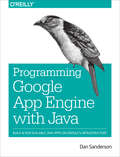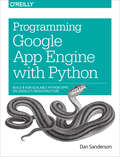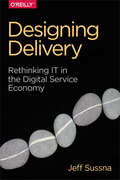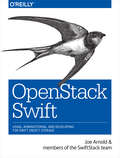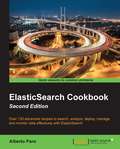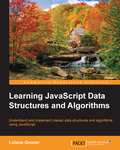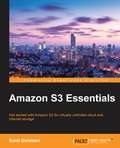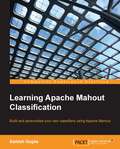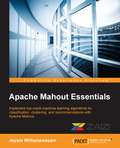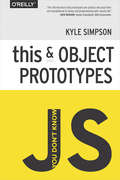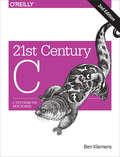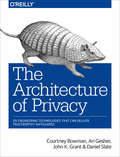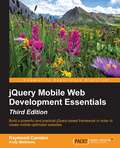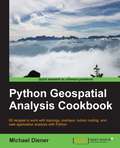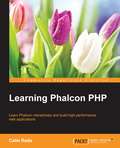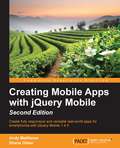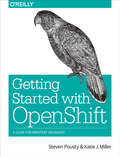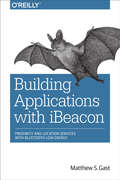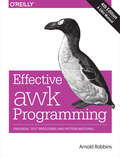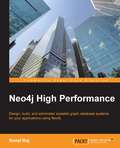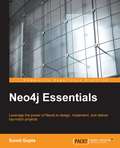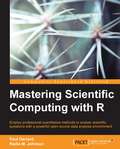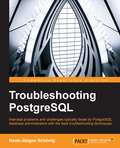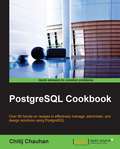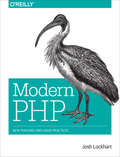- Table View
- List View
Programming Google App Engine with Java
by Dan SandersonThis practical guide shows intermediate and advanced web and mobile app developers how to build highly scalable Java applications in the cloud with Google App Engine. The flagship of Google's Cloud Platform, App Engine hosts your app on infrastructure that grows automatically with your traffic, minimizing up-front costs and accommodating unexpected visitors. You'll learn hands-on how to perform common development tasks with App Engine services and development tools, including deployment and maintenance.For Java applications, App Engine provides a J2EE standard servlet container with a complete Java 7 JVM and standard library. Because App Engine supports common Java API standards, your code stays clean and portable.Get a hands-on introduction to App Engine's tools and features, using an example applicationSimulate App Engine on your development machine directly from EclipseStructure your app into individually addressable modules, each with its own scaling configurationExploit the power of the scalable Cloud Datastore, using queries, transactions, and data modeling with JPAUse Cloud SQL for standard relational databases with App Engine applicationsLearn how to deploy, manage, and inspect your application on Google infrastructure
Programming Google App Engine with Python
by Dan SandersonThis practical guide shows intermediate and advanced web and mobile app developers how to build highly scalable Python applications in the cloud with Google App Engine. The flagship of Google's Cloud Platform, App Engine hosts your app on infrastructure that grows automatically with your traffic, minimizing up-front costs and accommodating unexpected visitors. You'll learn hands-on how to perform common development tasks with App Engine services and development tools, including deployment and maintenance.App Engine's Python support includes a fast Python 2.7 interpreter, the standard library, and a WSGI-based runtime environment. Choose from many popular web application frameworks, including Django and Flask.Get a hands-on introduction to App Engine's tools and features, using an example applicationSimulate App Engine on your development machine with tools from Google Cloud SDKStructure your app into individually addressable modules, each with its own scaling configurationExploit the power of the scalable Cloud Datastore, using queries, transactions, and data modeling with the ndb libraryUse Cloud SQL for standard relational databases with App Engine applicationsLearn how to deploy, manage, and inspect your application on Google infrastructure
Designing Delivery
by Jeff SussnaNow that we're moving from a product economy to a digital service economy, software is becoming critical for navigating our everyday lives. The quality of your service depends on how well it helps customers accomplish goals and satisfy needs. Service quality is not about designing capabilities, but about making--and keeping--promises to customers.To help you improve customer satisfaction and create positive brand experiences, this pragmatic book introduces a transdisciplinary approach to digital service delivery. Designing a resilient service today requires a unified effort across front-office and back-office functions and technical and business perspectives. You'll learn how make IT a full partner in the ongoing conversations you have with your customers.Take a unique customer-centered approach to the entire service delivery lifecycleApply this perspective across development, operations, QA, design, project management, and marketingImplement a specific quality assurance methodology that unifies those disciplinesUse the methodology to achieve true resilience, not just stability
OpenStack Swift
by Joe ArnoldGet up and running with OpenStack Swift, the free, open source solution for deploying high-performance object storage clusters at scale. In this practical guide, Joe Arnold, co-founder and CEO of SwiftStack, brings you up-to-speed on the basic concepts of object storage and walks you through what you need to know to plan, build, operate, and measure the performance of your own Swift storage system.Object storage is essential today with the growth of web, mobile, and software-as-a-service (SaaS) applications. This book helps you through the process, with separate sections on application development, installation, administration, and troubleshooting.Learn Swift's concepts for organizing, distributing, and serving dataExplore basic and advanced features of the Swift RESTful APIDelve into Swift's many client libraries, including useful Python featuresWrite middleware to customize and simplify your storage systemUnderstand requirements for planning a Swift deployment--including your specific use caseLearn options for coaxing the best performance from your clusterGet best practices for daily operations, such as monitoring and planning capacity additionsPick up techniques for testing and benchmarking your Swift cluster
ElasticSearch Cookbook - Second Edition
by Alberto ParoIf you are a developer who implements ElasticSearch in your web applications and want to sharpen your understanding of the core elements and applications, this is the book for you. It is assumed that you've got working knowledge of JSON and, if you want to extend ElasticSearch, of Java and related technologies.
Learning JavaScript Data Structures and Algorithms
by Loiane GronerIf you are a JavaScript developer or someone who has basic knowledge of JavaScript, and want to explore its optimum ability, this fast-paced book is definitely for you. Programming logic is the only thing you need to know to start having fun with algorithms.
Amazon S3 Essentials
by Sunil GulabaniGet started with Amazon S3 for virtually unlimited cloud and Internet storageAbout This BookFamiliarize yourself with the concepts of Amazon S3Understand basic operations of bucket, folders, and objects using Amazon S3 SDK JavaLeverage the power of Amazon S3 to effectively store and retrieve dataWho This Book Is ForThis book is intended for System Engineers/ Developers, Software Architects, Project managers, and users who want to explore Amazon S3 SDK Java. If you want to learn about Amazon S3 quickly, then this book is for you. Basic knowledge of Java programming is expected.What You Will LearnStart with the basic concepts of Amazon S3 to get you goingUse Copy Object and Multipart Copy Object for objects of different sizesUnderstand how to use the amazon management console for Amazon S3Learn how to use the AWS SDK of Java and consume the Amazon S3Get to grips with managing the bucket life cycleConfigure CORS to share resources to a different domainDiscover how to develop and deploy the static website on Amazon S3 using different services of AmazonIn DetailAmazon Simple Storage Service (Amazon S3), provides developers and IT teams with secure, durable, and highly-scalable object storage. Amazon S3 is easy to use, with a simple web services interface to store and retrieve any amount of data from anywhere on the web.S3 is automatically web scalable and responds to the requirements of your application and traffic, and therefore offers a key element to help companies deal dynamically with any spike in traffic for their application (such as a free e-book offer).This book starts with the basics of the Amazon S3 and its features, and you will quickly get an understanding how to use the Amazon Management Console for Amazon S3 which is the simplest way to manage Amazon S3. Next, we will cover basic operations on bucket, folder, objects. Once the basic operations are understood, you will know how to use Amazon S3 using Java SDK. Following that, you will learn about Copy Objects and Multipart copy objects for large objects size. You will also learn to manage the life cycle of bucket and how to share resources to the different domain by configuring CORS. The book will then guide you through the development and deployment of a static website on Amazon S3 using different services of Amazon.By the end of the book, you will be able to create a scalable application using Amazon S3.Style and approachThis fast-paced book is a pragmatic guide to writing Amazon S3 applications. Each chapter is blended beautifully with lucid concepts and pertinent examples.
Learning Apache Mahout Classification
by Ashish GuptaIf you are a data scientist who has some experience with the Hadoop ecosystem and machine learning methods and want to try out classification on large datasets using Mahout, this book is ideal for you. Knowledge of Java is essential.
Apache Mahout Essentials
by Jayani WithanawasamIf you are a Java developer or data scientist, haven't worked with Apache Mahout before, and want to get up to speed on implementing machine learning on big data, then this is the perfect guide for you.
You Don't Know JS: this & Object Prototypes
by Kyle SimpsonNo matter how much experience you have with JavaScript, odds are you don't fully understand the language. This concise, in-depth guide takes you inside JavaScript's this structure and object prototypes. You'll learn how they work and why they're integral to behavior delegation--a design pattern in which objects are linked, rather than cloned.Like other books in the "You Don't Know JS" series, this and Object Prototypes dives into trickier parts of the language that many JavaScript programmers simply avoid. Armed with this knowledge, you can become a true JavaScript master.With this book you will:Explore how the this binding points to objects based on how the function is calledLook into the nature of JS objects and why you'd need to point to themLearn how developers use the mixin pattern to fake classes in JSExamine how JS's prototype mechanism forms links between objectsLearn how to move from class/inheritance design to behavior delegationUnderstand how the OLOO (objects-linked-to-other-objects) coding style naturally implements behavior delegation
21st Century C: C Tips from the New School
by Ben KlemensThrow out your old ideas about C and get to know a programming language that’s substantially outgrown its origins. With this revised edition of 21st Century C, you’ll discover up-to-date techniques missing from other C tutorials, whether you’re new to the language or just getting reacquainted.C isn’t just the foundation of modern programming languages; it is a modern language, ideal for writing efficient, state-of-the-art applications. Get past idioms that made sense on mainframes and learn the tools you need to work with this evolved and aggressively simple language. No matter what programming language you currently favor, you’ll quickly see that 21st century C rocks.Set up a C programming environment with shell facilities, makefiles, text editors, debuggers, and memory checkersUse Autotools, C’s de facto cross-platform package managerLearn about the problematic C concepts too useful to discardSolve C’s string-building problems with C-standard functionsUse modern syntactic features for functions that take structured inputsBuild high-level, object-based libraries and programsPerform advanced math, talk to internet servers, and run databases with existing C librariesThis edition also includes new material on concurrent threads, virtual tables, C99 numeric types, and other features.
The Architecture of Privacy
by Daniel Slate John K Grant Elissa Lerner Ari Gesher Courtney BowmanTechnology's influence on privacy not only concerns consumers, political leaders, and advocacy groups, but also the software architects who design new products. In this practical guide, experts in data analytics, software engineering, security, and privacy policy describe how software teams can make privacy-protective features a core part of product functionality, rather than add them late in the development process.Ideal for software engineers new to privacy, this book helps you examine privacy-protective information management architectures and their foundational components--building blocks that you can combine in many ways. Policymakers, academics, students, and advocates unfamiliar with the technical terrain will learn how these tools can help drive policies to maximize privacy protection.Restrict access to data through a variety of application-level controlsUse security architectures to avoid creating a single point of trust in your systemsExplore federated architectures that let users retrieve and view data without compromising data securityMaintain and analyze audit logs as part of comprehensive system oversightExamine case studies to learn how these building blocks help solve real problemsUnderstand the role and responsibilities of a Privacy Engineer for maintaining your privacy architecture
jQuery Mobile Web Development Essentials - Third Edition
by Raymond Camden Andy MatthewsBuild a powerful and practical jQuery-based framework in order to create mobile-optimized websites About This Book * Build websites with jQuery Mobile that work beautifully across a wide range of mobile devices * Become a competent jQuery Mobile developer and learn the building blocks of jQuery Mobile's component-driven design * This book covers key concepts but with a focus on providing the practical skills required Who This Book Is For This book is for any web developer who is looking to create mobile-optimized websites. Basic knowledge of HTML is required. Minor familiarity with JavaScript would help but is not required. What You Will Learn * Create mobile-optimized sites using simple HTML * Structure your sites so users can browse them on mobile devices * Find out how to work with multiple pages in the JQM framework and embed multiple pages in HTML files * Enhance simple pages using various toolbars * Include mobile-optimized forms for interactive sites * Convert desktop sites into mobile versions * Use HTML5's local storage feature in jQuery Mobile to include persistent client-side storage * Explore the rich sets of widgets and themes available and discover how to modify them for use in your jQuery Mobile site In Detail jQuery Mobile is a HTML5-based touch-optimized web framework. jQuery Mobile can be used to build responsive cross-platform websites and apps for a wide range of smartphones, tablets, and desktop devices. The jQuery Mobile framework can be integrated with other mobile app frameworks such as PhoneGap, IBM Worklight, and more. Introduction to jQuery Mobile explains how to add the framework to your HTML pages to create rich, mobile-optimized web pages with minimal effort. You'll learn how to use jQuery Mobile's automatic enhancements and configure the framework for customized, powerful mobile-friendly websites. We then dig into forms, events, and styling. You'll see how jQuery Mobile automatically enhances content, and will find out how to use the JavaScript API to build complex sites. We'll introduce you to how jQuery Mobile can be themed as well looking into how JavaScript can be used for deep sets of customizations. The examples are ready to run and can be used to help kick-start your own site. Along the way, you will leverage all the concepts you learn to build three sample mobile applications. Style and approach Through a set of easy to follow instructions, we'll show you how to use jQuery Mobile's features one easy-to-use widget at a time. You'll see examples for each feature as well as screenshots to demonstrate what they should look like on a mobile device. You can then take these example files and modify them as you learn to experiment.
Python Geospatial Analysis Cookbook
by Michael DienerOver 60 recipes to work with topology, overlays, indoor routing, and web application analysis with Python About This Book * Explore the practical process of using geospatial analysis to solve simple to complex problems with reusable recipes * Concise step-by-step instructions to teach you about projections, vector, raster, overlay, indoor routing and topology analysis * Create a basic indoor routing application with geodjango Who This Book Is For If you are a student, teacher, programmer, geospatial or IT administrator, GIS analyst, researcher, or scientist looking to do spatial analysis, then this book is for you. Anyone trying to answer simple to complex spatial analysis questions will get a working demonstration of the power of Python with real-world data. Some of you may be beginners with GIS, but most of you will probably have a basic understanding of geospatial analysis and programming. What You Will Learn * Discover the projection and coordinate system information of your data and learn how to transform that data into different projections * Import or export your data into different data formats to prepare it for your application or spatial analysis * Use the power of PostGIS with Python to take advantage of the powerful analysis functions * Execute spatial analysis functions on vector data including clipping, spatial joins, measuring distances, areas, and combining data to new results * Create your own set of topology rules to perform and ensure quality assurance rules in Python * Find the shortest indoor path with network analysis functions in easy, extensible recipes revolving around all kinds of network analysis problems * Visualize your data on a map using the visualization tools and methods available to create visually stunning results * Build an indoor routing web application with GeoDjango to include your spatial analysis tools built from the previous recipes In Detail Geospatial development links your data to places on the Earth's surface. Its analysis is used in almost every industry to answer location type questions. Combined with the power of the Python programming language, which is becoming the de facto spatial scripting choice for developers and analysts worldwide, this technology will help you to solve real-world spatial problems. This book begins by tackling the installation of the necessary software dependencies and libraries needed to perform spatial analysis with Python. From there, the next logical step is to prepare our data for analysis; we will do this by building up our tool box to deal with data preparation, transformations, and projections. Now that our data is ready for analysis, we will tackle the most common analysis methods for vector and raster data. To check or validate our results, we will explore how to use topology checks to ensure top-quality results. This is followed with network routing analysis focused on constructing indoor routes within buildings, over different levels. Finally, we put several recipes together in a GeoDjango web application that demonstrates a working indoor routing spatial analysis application. The round trip will provide you all the pieces you need to accomplish your own spatial analysis application to suit your requirements. Style and approach Easy-to-follow, step-by-step recipes, explaining from start to finish how to accomplish real-world tasks.
Learning Phalcon PHP
by Calin RadaLearn Phalcon interactively and build high performance web applications About This Book * Learn how to install and configure Phalcon PHP on your server * Develop a fully functional multi-module application with Phalcon PHP * A step-by-step guide with in-depth coverage of Phalcon and best practices Who This Book Is For If you are a web developer and want to build effective web applications with Phalcon PHP, then this book is ideal for you. The book does not assume detailed knowledge of PHP frameworks. What You Will Learn * Compile and install Phalcon from source code * Set up an MVC project and learn how to use the Dependency Injection (DI), configuration, and routing * Get to grips with Phalcon's ORM, ODM, validation and caching, and generate models using Phalcon Developer Tools * Create a command-line application from scratch * Write a fully functional REST module with Phalcon PHP * Use Volt as template engine to create your first views * Understand how session works and learn how to implement an authentication system In Detail Phalcon is a full-stack PHP framework implemented as a C extension. Building applications with Phalcon will offer you lower resource consumption and high performance whether your application runs on a Linux machine or a Windows one. Phalcon is loosely coupled, allowing you to use its objects as glue components based on the needs of your application. Phalcon PHP's mission is to give you an advanced tool to develop faster websites and applications. This book covers the most common and useful parts of PhalconPHP, which will guide you to make the right decisions while developing a Phalcon-driven application. You will begin the journey by installing and setting up Phalcon for your environment followed by the development of each module. You will be introduced to Phalcon's ORM and ODM. Furthermore, you will also be able to create the first models and database architecture for your project. You will then cover command-line applications, API module, volt syntax, and hierarchical views. Installing and working with Node and Bower for assets management will also be covered. Finally, you will gain insights into creating the backoffice and frontend module along with best practices and resources for development with Phalcon PHP. By the end of this book, you will be able to confidently develop any kind of application using the Phalcon PHP framework in a short time. Style and approach This step-by-step guide will walk you through the fundamentals of Phalcon PHP. It will then help you to create a simple but fully functional news website and gain advanced knowledge of how Phalcon PHP works.
Creating Mobile Apps with jQuery Mobile - Second Edition
by Shane Gliser Andy MatthewsThis book assumes a basic level of experience with standard web development. If you've used jQuery Mobile before, you're good to go. Otherwise, you can pick it up along the way.
Getting Started with OpenShift
by Steve Pousty Katie MillerIntrigued by the possibilities of developing web applications in the cloud? With this concise book, you get a quick hands-on introduction to OpenShift, the open source Platform as a Service (PaaS) offering from Red Hat. You'll learn the steps necessary to build, deploy, and host a complete real-world application on OpenShift, without having to read long, detailed explanations of the technologies involved.Though the book uses Python, application examples in other languages are available on GitHub. If you can build web applications, use a command line, and program in Java, Python, Ruby, Node.js, PHP, or Perl, you're ready to get started.Dive in and create your first example application with OpenShiftModify the example with your own code and hot-deploy the changesAdd components such as a database, task scheduling, and monitoringUse external libraries and dependencies in your applicationDelve into networking, persistent storage, and backup optionsExplore ways to adapt your team processes to use OpenShiftLearn OpenShift terms, technologies, and commandsGet a list of resources to learn more about OpenShift and PaaS
Building Applications with iBeacon
by Matthew S. GastHigh-precision location information is increasingly useful for mobile application developers, since it allows devices to interact with the world around them. This practical book shows you how to achieve arm's reach accuracy with iBeacons, simple transmitters that enable your applications to react to nearby surroundings and then deliver timely, relevant information--especially indoors, where GPS and cell service are inaccurate.Whether you're enabling a map, giving users directions, creating a game, recommending purchases, letting users check in, or creating an immersive experience, you'll learn how iBeacons provide precise location information, empowering your applications to engage and interact with users nearby.Get examples of several application types you can build with iBeaconsLearn how iBeacons provide applications with proximity informationSet up, activate, and test iBeacons on both specialized and general-purpose hardwareExplore the APIs and tools you need to develop location-aware mobile applicationsUse built-in iOS features to interact with iBeacons, including PassbookBuild networks to help shoppers, travelers, conference attendees, and others find what they're looking for
Effective awk Programming: Universal Text Processing and Pattern Matching
by Arnold RobbinsWhen processing text files, the awk language is ideal for handling data extraction, reporting, and data-reformatting jobs. This practical guide serves as both a reference and tutorial for POSIX-standard awk and for the GNU implementation, called gawk. This book is useful for novices and awk experts alike.In this thoroughly revised edition, author and gawk lead developer Arnold Robbins describes the awk language and gawk program in detail, shows you how to use awk and gawk for problem solving, and then dives into specific features of gawk. System administrators, programmers, webmasters, and other power users will find everything they need to know about awk and gawk. You will learn how to:Format text and use regular expressions in awk and gawkProcess data using awk's operators and built-in functionsManage data relationships using associative arraysDefine your own functions"Think in awk" with two full chapters of sample functions and programsTake advantage of gawk's many advanced featuresDebug awk programs with the gawk built-in debuggerExtend gawk by writing new functions in C or C++This book is published under the terms of the GNU Free Documentation License. You have the freedom to copy and modify this GNU manual.Royalties from the sales of this book go to the Free Software Foundation and to the author.
Neo4j High Performance
by Sonal RajIf you are a professional or enthusiast who has a basic understanding of graphs or has basic knowledge of Neo4j operations, this is the book for you. Although it is targeted at an advanced user base, this book can be used by beginners as it touches upon the basics. So, if you are passionate about taming complex data with the help of graphs and building high performance applications, you will be able to get valuable insights from this book.
Neo4j Essentials
by Sumit GuptaIf you are an application developer or software architect who wants to dive into the Cypher language and learn the concepts of graph theory and graph-based data models, this is the book for you. Prior experience with a graph-based or NoSQL-based database is expected. Some knowledge of Java will be beneficial, as this will give you more insights into Neo4j's extensibility.
Mastering Scientific Computing with R
by Paul Gerrard Radia M. JohnsonIf you want to learn how to quantitatively answer scientific questions for practical purposes using the powerful R language and the open source R tool ecosystem, this book is ideal for you. It is ideally suited for scientists who understand scientific concepts, know a little R, and want to be able to start applying R to be able to answer empirical scientific questions. Some R exposure is helpful, but not compulsory.
Troubleshooting PostgreSQL
by Hans-Jurgen SchonigIf you are a database administrator looking for solutions to common PostgreSQL problems, this is the book for you. The book is suitable for people with intermediate and professional expertise.
PostgreSQL Cookbook
by Chitij ChauhanIf you are a system administrator, database administrator, architect, developer, or anyone with an interest in planning, managing, and designing database solutions using PostgreSQL, this is the book for you. This book is suited for you if you have some prior experience with any relational database or with the SQL language.
Modern PHP
by Josh LockhartPHP is experiencing a renaissance, though it may be difficult to tell with all of the outdated PHP tutorials online. With this practical guide, you'll learn how PHP has become a full-featured, mature language with object-orientation, namespaces, and a growing collection of reusable component libraries.Author Josh Lockhart--creator of PHP The Right Way, a popular initiative to encourage PHP best practices--reveals these new language features in action. You'll learn best practices for application architecture and planning, databases, security, testing, debugging, and deployment. If you have a basic understanding of PHP and want to bolster your skills, this is your book.Learn modern PHP features, such as namespaces, traits, generators, and closuresDiscover how to find, use, and create PHP componentsFollow best practices for application security, working with databases, errors and exceptions, and moreLearn tools and techniques for deploying, tuning, testing, and profiling your PHP applicationsExplore Facebook's HVVM and Hack language implementations--and how they affect modern PHPBuild a local development environment that closely matches your production server
